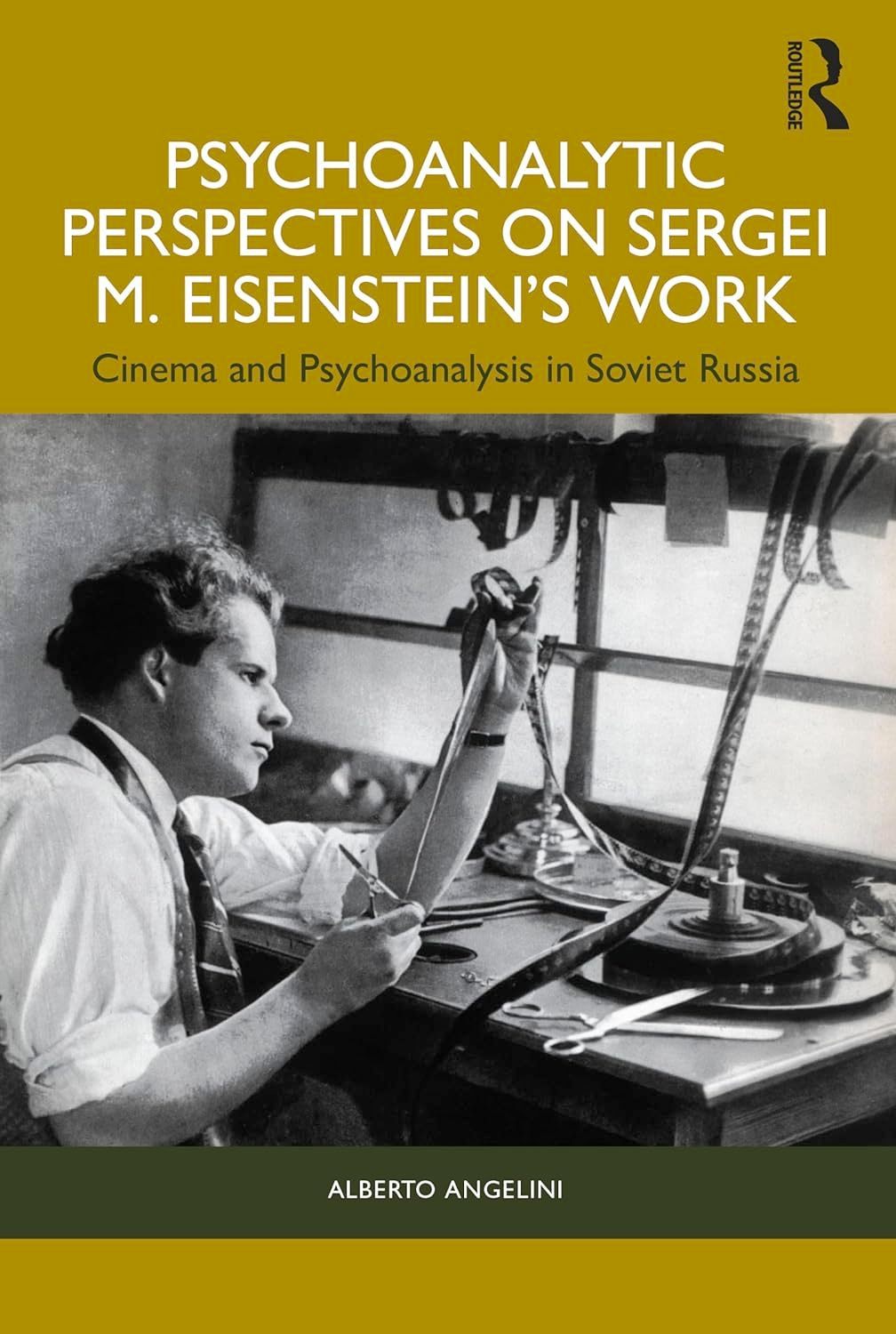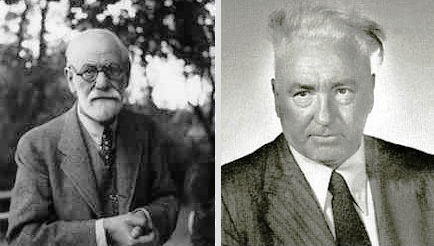
Sergei M. Eisenstein: Psychoanalysis and Psychology
Alberto Angelini (2021)
Routledge, London, 2024
One of the most celebrated Russian directors, Sergei M. Eisenstein was deeply interested in psychology and psychoanalysis. He was a friend of Lev Vygotsky, founder of the Cultural Historical Psychology, and well acquainted with Aleksandr Luria, founder of neuropsychology. Both Vygotsky and Luria embraced psychoanalysis and promoted it within Russia in the 1920s. Luria was President of the Psychoanalytic Society of Moscow which hosted many brilliant young revolutionaries. Vygotsky’s notions of psychology can be traced in Eisenstein’s work on filmic language in the definition of the phenomenon of agglutination and in the idea of inner world. Eisenstein confronts with these notions from different perspectives in his theory on film editing. With concern to psychoanalysis, Eisenstein was particularly drawn by the issue of regression: art viewers must regress when experiencing art, cinema included, and in the process of regression they activate the most mature part of their psyche. It is the artist’s task to inspire this process. Eisenstein was also acquainted with Hanns Sachs and had the opportunity to meet Otto Rank, Sándor Ferenczi, Franz Alexander, and Wilhelm Reich. In 1929 he gave a lecture at the Institute of Psychoanalysis of Berlin, where he met Kurt Lewin, one of the founders of Gestalt. In URSS and in the USA he had two short experiences of psychoanalytically oriented therapy. But under Stalin’s regime, psychoanalysis eventually became associated with Trotskyism by regime’s theoreticians and Eisenstein was one of the many involved in the severe reprimand that followed. Apparently, he was summoned personally by Stalin, to be chided. Consequently, the director had to engage in a sort of self-criticism, once back from the USA, in 1935, at a conference of Soviet cinematography operators. The same sort of condemn was directed towards Vygotsky’s psychological ideas. A resolution of the Central Committee of the Communist Party of the Soviet Union (POCUS) condemned the “pedologic theories” of the psychologist. In addition to that, in the same circumstance, the relativity theory and the studies propaedeutic to molecular biology were also condemned, halting the progress, within these domains, of Soviet science for decades.
Discourse around subconscious and psychoanalytical theories had to wait till 1970s to be revived.
Eisenstein claims that art is an anthropological enterprise intrinsic to human culture and capable to develop in history. The pattern of art can be investigated looking at many disciplines, not only humanistic. The common denominator, which ensures this conceptual cosmopolitanism, is dialectic philosophy.
Both Eisenstein and Vygotsky saw dialectics as the most advanced model of insight and knowledge, in arts and in psychology, both within a theoretical domain and a practical frame. Eisenstein and the multidisciplinary group of young intellectuals that he attended gathered around dialectic thought from a Marxist perspective. In the first half of the twentieth century, human sciences were animated by a lively exchange on art and esthetics. Sergei Michajlovič Eisenstein was one of the major protagonists within this exchange and confrontation. The formal autonomy of cinema, in the art system, was consolidated by his filmic and theoretical works. The director’s creative work, since its very beginning and in a very distinctive way, went along with a remarkable and originally valuable cognitive examination of the conceptual issues related to art. He tackled the issue of art as connected to its specific thinking suggesting and introducing new ideas. While deepening his knowledge in that stream of research, Eisenstein was always interested – in a creative and conscious way – in the different and heterogeneous theoretical voices which animated European at the time.
Besides the value of his work from the perspective of an artistic and cinematographically critical analysis, Eisenstein’s ideas are groundbreaking from many perspectives; art belongs, structurally speaking, to human beings and develops through human history. At the same time, the director emphasizes his idea that in its evolutionary path, art can be investigated by many disciplines, not only humanistic. Psychology and psychoanalysis, because of their capability to investigate various aspects of the human psyche, represent unique instruments for research and understanding. From Eisenstein’s perspective, research must take place considering a rigorous analytical methodology, philosophically credible. The issue of methodology, fundamental within the Marxist philosophical scenario, is embraced by the director as a desirable resolutive instrument. In fact, the epistemological question is intertwined with the essence of scientific and humanistic disciplines, throughout the 20th century. Even today, due to the many aleatory and eccentric ideas that have been emerging, in the fields of psychology and psychoanalysis the criterion of method remains the most important instrument to discern the validity of the different theoretical and clinical proposals.
Eisenstein’s artistic and intellectual contribution was rich and wide-ranging; his ideas developed and thrived through the years, reaching a peak, in the last part of the director’s life, in his unfinished work, whose significant title is Metod. Unpublished till some years ago, in this work the author collected several ideas and topics investigated from 1932 to 1948, the year of his death.
In fact, since the beginning of his work, the foundation of Eisenstein’s theoretical enterprise lies in the method. His work on film editing and direction and his paper on what could be valued as an essay on esthetics depicting his conceptual model – Non-indifferent Nature, written between 1945 and 1947 – were supposed to be included in the ‘theoretical enterprise’. The director’s project was extremely engaging, and it aimed at understanding the meaning of any intersectional space between cinema and human disciplines. Eisenstein was a theoretician with wide interdisciplinary interests and his work examined the space among different sciences.
Eisenstein connected, simultaneously, anything that could make intellectual enterprise progress, in full respect of methodological criteria, embracing contributions from anthropology, linguistics, psychology, art history, esthetics, and biology.
This superior and organic synthesis is not limited to single disciplines, but it occupies dialectically the territory of the speculative thought that keeps opposites apart (e.g., sense and sensibility, art and science, abstraction and concrete activity). Cinema recomposes, not statically but in a dialectic and mobile form of conflict, these crystallized opposites. Cinema possesses this faculty, both ideal and concrete, because of its capability to be set in motion. Going beyond Eisenstein’s original intuition, “cinema discourse” is similar to “discourse around thinking”. In that, he gets connected with the psychological notions expressed by his friend Lev Vygotsky. This theoretical pattern makes cinema to be bound not only to different fields of knowledge but also, and most importantly, as it happens in the psyche, to connect the dimension of the emotional sphere to abstract thinking.




